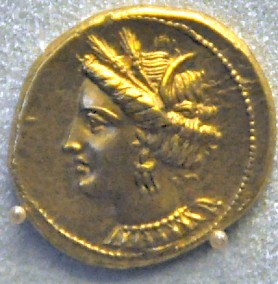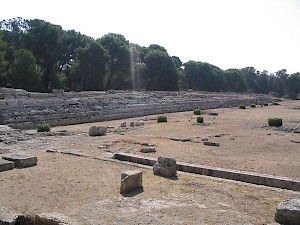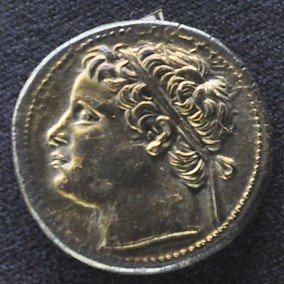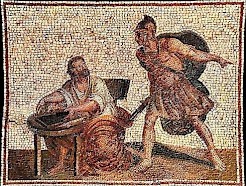History of Syracuse (5)
Q1954223Syracuse: the ancient capital of Sicily.
The Coming of Rome

In 264, one of the Roman consuls, Appius Claudius Caudex, invaded Sicily with two legions and captured Messana: the First Punic War had broken out. The Carthaginians now allied itself to Syracuse - a most unusual action - and marched from their base at Acragas to Messana. Fighting was inconclusive, but Hiero of Syracuse witnessed the power of Rome, allied himself to the invader, and was recognized as amicus et socius, "fiend and ally" (263). Technically, the city was independent, but it soon lost its autonomy.
Next summer, the Romans laid siege to Acragas and captured the Carthaginian base (early 261), which had been defended by the same Hannibal who had garrisoned Messana. However, after these successes, the Roman war machine came to as standstill. The Carthaginians refused to accept Roman control of the Strait, and the Romans understood that they had to conquer the entire island. This meant that they had to gain naval superiority - something that would be very difficult, because the Romans were no sailors.
It was a conflict between an elephant and a whale, which could go on forever. However, the Romans had a secret weapon, called corvus ("raven" or "crow"). This was a movable bridge with a metal prong that could be dropped onto the deck of a Carthaginian ship. Once the two ships were tied to each other, the naval battle had changed into a land battle. In other words, the Romans used their ships as platforms for fighting. In 260, at Mylae, their consul Gaius Duillius defeated admiral Hannibal, and won Rome's first naval victory ever.

Yet, this victory was indecisive, and the war was to last very, very long. The Carthaginian commander Hamilcar was able to defend the western part of the island; and every Roman success was balanced by either a Carthaginian victory, Roman stupidity, or bad luck (e.g., the loss of a fleet in a storm). However, the Roman consul Gaius Atilius Regulus, having overcome the Carthaginian navy at Ecnomus, was able to repeat the invasion of Africa that had once been the masterplan of Agathocles of Syracuse, and although he was defeated, it was clear that Rome was the strongest of the two contenders. It had the resources to raise large armies and build new fleets, and most of all: it had a powerful ally, Syracuse.
The final years of the war looked like a stalemate on western Sicily, where Hamilcar fought a guerilla war, but only the Romans was able to recuperate. In 241, a new Roman fleet, commanded by Gaius Lutatius Catulus, overcame the last Carthaginian ships, commanded by Hanno, near the Aegatian islands in the far west. A peace treaty was signed, and Carthage accepted Roman rule in Sicily. According to the Greek historian Polybius of Megalopolis, it had been "the longest and most severely contested war in history".note
From now on, Sicily was a province of Rome - the first one, and it is interesting to see how the Romans organized the island, because this became a model to the organization of new conquests. In the first place, the Roman system of alliances was not extended to Sicily. It would be useless to ask the Sicilians to send troops to, say, northern Italy, and fight against the Gauls. Therefore, the Romans demanded a yearly tribute. The Sicilian tyrants had done the same, and this was a better way to run the cities, which retained their local autonomy.

A Roman magistrate, a praetor, was responsible for the administration of the island; his powers were almost unlimited, and the inhabitants of the island must have thought of him as some sort of tyrant. His financial officers, the two quaestores, demanded 10% of the harvest and had the prior right to buy additional wheat at a fixed prize. This system, called the Lex Hieronica after the Syracusan ruler, was widely regarded as a fair compromise between the demands of the rulers and the possibilities of the ruled. The Romans would employ it in Andalusia too.
So, the Romans conquered Sicily and learned how to organize their conquests as provinces. In fact, they copied the Syracusan system. The island remained quiet, and a city like Syracuse benefitted. King Hiero had money to spend: the theater was expanded, a large altar was built, and a new royal castle was built. The foundations for economic prosperity, although with little autonomy, were laid and Sicily remained quiet, even when Carthage and Rome started a second war in 218. During this Second Punic War, which became famous as Rome's war against Hannibal, Sicily was not the main war zone. Yet, Syracuse did not escape violence.

In 215 the loyal Hiero died, and his grandson Hieronymus immediately sided with Carthage. The Roman general Marcellus, however, was able to keep the island and laid siege to Syracuse. According to the stories, the scientist Archimedes designed all kinds of machines to defend the city (although the notorious story about the burning mirrors is untrue), but eventually, the city was betrayed, and the Romans sacked Syracuse. Archimedes was among the casualties.
Syracuse, once an ally of Rome, was now annexed to the Roman empire. All of Sicily had been conquered.